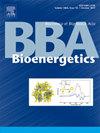Antarctic photosynthesis: energy transfer and charge separation in the diatom Chaetoceros simplex
IF 2.7
2区 生物学
Q2 BIOCHEMISTRY & MOLECULAR BIOLOGY
引用次数: 0
Abstract
The polar oceanic environment poses extreme challenges to photosynthetic organisms, which have evolved atypical strategies to maintain efficient photosynthesis in cold temperatures. Here, the psychrophilic diatom Chaetoceros simplex (C. simplex) is studied in vivo in the dark-adapted state using steady-state and time-resolved fluorescence methods. Our results show that all fucoxanthin chlorophyll a/c protein (FCP) antenna transfer energy to photosystem I (PSI) or photosystem II (PSII), with no detached FCPs. PSI exhibits no fluorescence of ‘red’ forms of chlorophyll (chl) beyond 700 nm in both 279 K and 77 K conditions. Despite this, it apparently has a long decay time of ~85 ps indicating the presence of a large core-antenna supercomplex. PSII has an average lifetime of ~500 ps in open state (QA oxidized) and ~1220 ps in closed state (QA reduced). PSII of C. simplex has kinetics that are slightly slower than temperate diatoms, suggesting larger antenna. In addition, fucoxanthin (fx) molecules of FCP that absorb in the 500–550 nm range (fx-red) transfer more energy to PSII than fx that absorb in the blue range (fx-blue, 462 nm max absorption). A subpopulation of red-shifted, aggregated FCPs are detected at 77 K, that are active in energy transfer uphill at 279 K. Overall, our results indicate relatively larger antenna of PSI and PSII and an absence of red chls in PSI of cold-adapted species, compared to temperate species.
南极光合作用:单面毛藻的能量转移和电荷分离。
极地海洋环境对光合生物提出了极端的挑战,这些生物已经进化出非典型的策略来维持在低温下有效的光合作用。本文采用稳态和时间分辨荧光方法,研究了在体内适应黑暗状态下的嗜冷硅藻单角毛藻(C. simplex)。结果表明,岩藻黄素叶绿素a/c蛋白(FCP)天线向光系统I (PSI)或光系统II (PSII)传递能量,不存在分离的FCP。在279 K和77 K条件下,PSI在700 nm以上没有“红色”形式的叶绿素(chl)荧光。尽管如此,它显然有~85 ps的长衰减时间,这表明存在一个大的核心天线超复体。PSII在开放状态(QA氧化)和关闭状态(QA还原)下的平均寿命分别为~500 ps和~1220 ps。单纯硅藻的PSII动力学略慢于温带硅藻,表明其天线较大。此外,FCP的岩藻黄素(fx)分子在500-550 nm范围内吸收(fx-red),比在蓝色范围吸收的fx分子(fx-blue,最大吸收462 nm)向PSII传递更多的能量。在77 K处检测到红移聚集的fcp亚群,它们在279 K上坡时活跃于能量转移。总体而言,我们的研究结果表明,与温带物种相比,冷适应物种的PSI和PSII的天线相对较大,并且在PSI中没有红chls。
本文章由计算机程序翻译,如有差异,请以英文原文为准。
求助全文
约1分钟内获得全文
求助全文
来源期刊

Biochimica et Biophysica Acta-Bioenergetics
生物-生化与分子生物学
CiteScore
9.50
自引率
7.00%
发文量
363
审稿时长
92 days
期刊介绍:
BBA Bioenergetics covers the area of biological membranes involved in energy transfer and conversion. In particular, it focuses on the structures obtained by X-ray crystallography and other approaches, and molecular mechanisms of the components of photosynthesis, mitochondrial and bacterial respiration, oxidative phosphorylation, motility and transport. It spans applications of structural biology, molecular modeling, spectroscopy and biophysics in these systems, through bioenergetic aspects of mitochondrial biology including biomedicine aspects of energy metabolism in mitochondrial disorders, neurodegenerative diseases like Parkinson''s and Alzheimer''s, aging, diabetes and even cancer.
 求助内容:
求助内容: 应助结果提醒方式:
应助结果提醒方式:


